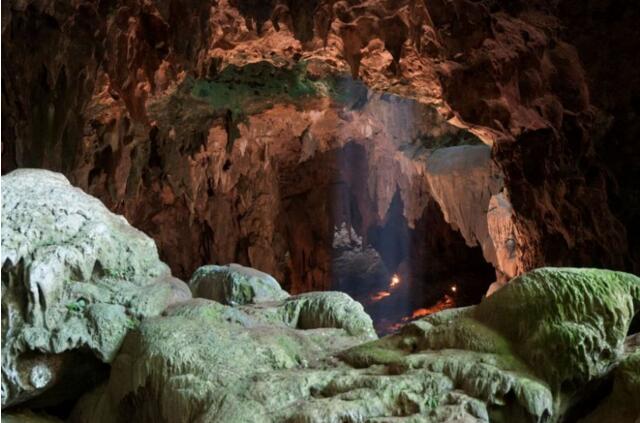 法国某洞穴中出土的一颗小牙齿颠覆了我们对早期人类的认知
法国某洞穴中出土的一颗小牙齿颠覆了我们对早期人类的认知
A tiny tooth unearthed from a French cave is upending what we know about early humans
译文简介
从一处法国洞穴中挖掘出的一枚儿童牙齿揭示了人类(智人)生活在西欧的最早期证据。
正文翻译

The excavation of Grotte Mandrin in France has revealed that early modern humans lived there some 54,000 years ago.
法国对格罗特曼陀林的发掘揭示了大约54000年前早期现代人类生活在那里
(CNN) — A child's tooth unearthed from a French cave has revealed the earliest evidence of humans -- Homo sapiens -- living in western Europe.
(美国有线电视新闻网)从一处法国洞穴中挖掘出的一枚儿童牙齿揭示了人类(智人)生活在西欧的最早期的证据。
The discovery of the molar from Grotte Mandrin, near Malataverne in the Rhône Valley in southern France, along with hundreds of stone tools dating back about 54,000 years ago, suggests that early humans lived in Europe about 10,000 years earlier than archaeologists had previously thought.
这颗来自法国南部罗纳河谷马拉塔凡尔纳旁边的格罗特·曼德林(Grotte Mandrin)的臼齿,伴随着数百件能追溯到约54000年前的石器的出土,表明早期人类开始生活在欧洲的时间比考古学家此前预计的还要提早了约一万年。
What's more, the Homo sapiens tooth was sandwiched between layers of Neanderthal remains, showing that the two groups of humans coexisted in the region. These findings challenge the narrative that the arrival of Homo sapiens in Europe triggered the extinction of Neanderthals, who lived in Europe and parts of Asia for about 300,000 years before disappearing.
不止如此,智人的牙齿像三明治一样被夹在了多层的尼安德特人遗骸中间,这说明两种人类在该地区共同生存过。这些发现构成了对智人到达欧洲造成尼安德特人灭绝这一叙事的挑战,而后者在欧洲和亚洲部分地区生活了大约30万年后才消失。
"We've often thought that the arrival of modern humans in Europe led to the pretty rapid demise of Neanderthals, but this new evidence suggests that both the appearance of modern humans in Europe and disappearance of Neanderthals is much more complex than that," said study coauthor Chris Stringer, a professor and research leader in human evolution at the Natural History Museum in London.
该研究参与者,任职伦敦自然历史博物馆的人类进化领域负责人,教授Chris Stringer说:“我们过去一般认为,正是现代人类在欧洲的到来导致了尼安德特人极为快速的消亡,但这次新发现的证据表明,现代人类在欧洲的出现和尼安德特人的消失这二者间的联系要复杂得多。”
It's the first time archaeologists have found evidence of alternating groups of Homo sapiens and Neanderthals living in the same place, and they rotated rapidly, even abruptly, at least twice, according to the study that published in the journal Science Advances on Wednesday.
根据周三发表在《科学进展》杂志上的研究显示,这是考古学家第一次发现智人和尼安德特人交替居住在同一个地方的证据,而且他们快速的轮换,甚至是突然发生的,这种情形至少发生了两次。
Previously, the arrival of early humans in Europe was dated to between 43,000 and 45,000 years ago, according to remains found in Italy and Bulgaria -- not long before the last surviving Neanderthal remains dating back 40,000 to 42,000 years ago were found. This time frx had led many to think the arrival of Homo sapiens and the disappearance of Neanderthals were inexorably lixed.
之前根据在意大利和保加利亚发现的遗骸推算,早期人类到达欧洲的时间可追溯到43000年至45000年前——在已发现的最后一具幸存的尼安德特人遗骸所追溯到的40000年至42000年前之前不久。这个时间框架让许多人认为智人的到来和尼安德特人的消失之间具有毋庸置疑的联系。
Humans and Neanderthals, who we know from genetic analysis encountered one another and had babies, resulting in Neanderthal traces in our DNA, overlapped for a much longer period in Europe, this study suggests.
这项研究表明,我们目前通过基因分析已知的现代智人和尼安德特人相遇并生育后代,导致我们的基因中有尼安德特人的基因片段这一族群融合事件所发生的时间在欧洲要长得多。
Clues from ancient stone tools
古石器带来的线索
Did humans and Neanderthals hang out together in this French cave overlooking the Rhône valley? The researchers don't have any hard evidence of interaction between the two groups.
The tools found in the layers representing the Homo sapiens and Neanderthal occupations are distinct in style and don't show any sign that they taught one another knapping or flaking stonework techniques. The stone tools associated with humans, known as Neronian tools, are smaller than those used by Neanderthals, known as Mousterian tools.
But the authors feel that it's likely that the two groups must have bumped into one another in the neighborhood -- even if direct contact didn't take place in this particular cave.
The hundreds of stone tools found at the site suggest that the rock shelter was occupied intensively by both groups of humans -- and was not just a place for an occasional stopover
人类和尼安德特人曾在这个能俯瞰罗纳河谷的法国洞穴里携手闲逛吗?研究人员没有任何证明这两个群体间发生过互动的确凿证据。 出土的智人和尼安德特人的工具在工作风格上是截然不同的,也没有迹象表明他们互相传授过打碎和剥片的石工技艺。人类使用过的被称为Neronian的石器,比尼安德特人使用的莫斯特风格的工具要小。 但笔者认为,这两个群体一定在附近偶遇过——即便不是在这个特别的洞穴里直接接触。在该遗址发现的数百件石器表明,这一岩石避难所被两组人群密集地占据,而且不仅仅是一个偶尔歇脚的地方。
Astonishingly, the team was able to determine that the period between the Neanderthals relocating and the first modern humans moving into the cave 56,000 years ago was just one year. The researchers did this by mapping and analyzing soot deposits from fires made by humans in the cave.
令人惊讶的是,研究小组能够确定,从尼安德特人搬离到5.6万年前第一批现代人类走进洞穴,之间只隔了一年时间。研究人员通过绘制和分析洞穴中人类生火遗留下的烟灰沉积层来判断出这一点。
"The soot is deposited to the roof of the rock shelter, and when there was a period of no one living there, there's no soot deposition," explained Stringer.
“烟灰沉积在洞顶上,当一段时间内没有人继续居住,就没有烟灰沉积,”Stringer解释说。
Lead author Ludovic Slimak, a researcher at the French National Centre for Scientific Research and the University of Toulouse who has been working on the site for 30 years, said he believed the two groups must have exchanged knowledge in some way.
第一作者Ludovic Slimak是法国国家科学研究中心和图卢兹大学的研究员,已经在这个遗址投注了30年精力,并且坚信这两个团体一定曾以某种方式交流过知识。
Right from the beginning of their occupation, Slimak said, the modern humans were using flint sourced from hundreds of kilometers away, the stone tools found in the cave show. That knowledge likely came from the indigenous Neanderthals, Slimak explained.
Slimak说,从智人刚开始在这居住的时候,就已经在使用远在数百公里外的燧石了,这些石器在洞穴中被发现,Slimak解释说,这些经验很可能就来自当地的尼安德特人。
"The territory appears to be immediately well known by Homo sapiens, and they immediately know flint sources that are very localized," he said.
“这块领地似乎立即被智人所熟知,他们立刻就知道了当地的燧石该从哪找。”
评论翻译
无
很赞 ( 2 )
收藏